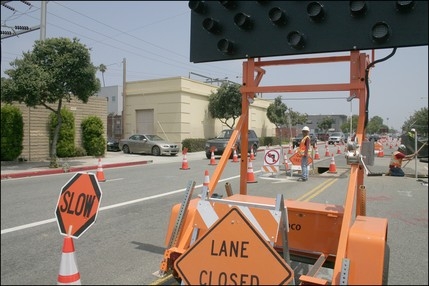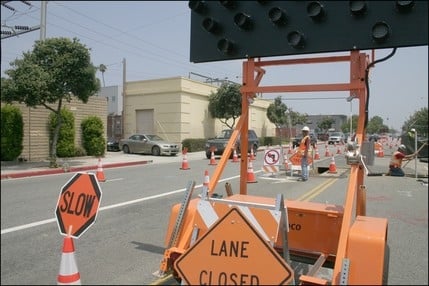
CITY HALL — In a private ceremony Monday, state, county and city officials enthusiastically broke ground on what will eventually be the final stop on the Exposition Light Rail Line at Fourth Street and Colorado Boulevard.
During that ceremony, they pledged to get the project completed by 2015.
But on Tuesday, the City Council was presented with how little is actually finalized about the project — and then there’s that lawsuit by residents trying to stop the line in its tracks.
The basic statistics are out there.
The line will be 6.6 miles from Culver City, where the first phase of the $2.4 billion project ends, to its terminus in Downtown Santa Monica.
Seven stops, three of which are in Santa Monica, will comprise the second phase, which is expected to cost $1.5 billion. Most of those will have parking.
Current modeling projections estimate that by 2030, the line will transport 64,000 riders daily.
“We expect that’s on the low side,” said Rick Thorpe, the CEO of the construction authority.
While Expo has a number of projections, the one thing it can’t predict at this point is the start date of construction.
Crews have been out for weeks doing potholing work and checking for utilities on Colorado Avenue and elsewhere on the line, but that’s all preliminary to actual construction.
In fact, whatever the golden shovels at the groundbreaking may have suggested, much of the line as it pertains to Santa Monica is still in the design phases.
That particularly applies to what Expo calls “betterments,” or improvements on the basic design for each station that City Hall specifically requests.
One example of that would be the side platform at Bergamot Station, which would allow riders to exit the train on either side for better access to the Bergamot Transit Village, a mixed-use development planned for the area.
The side platform also reduces the footprint of the station and leaves more room for the 17-mile bike path that previous designs had narrowed to the point that bicyclists would have had to dismount at Bergamot Station.
“That’s one of the advantages of the side platform,” said Francie Stefan, a community and strategic planning manager with City Hall. “When (the platform) was between the two tracks, they had to straddle it. With the side platform, it narrowed that. That’s a real advantage of the layout.”
Those designs, while conceptualized, haven’t been priced out yet, and will return to the council at a later meeting, Thorpe said.
Design aside, Expo couldn’t begin construction if it wanted to.
In March 2010, a coalition of homeowners’ groups called Neighbors for Smart Rail filed a lawsuit against Expo, asking it to go back to its environmental impact report and take another look at the consequences of putting at-grade crossings on certain streets.
The coalition contended that the report didn’t address the potential problem in any way, said founder Terri Tippit.
“If we prevail, all it means is they have to do another EIR and look at grade separation differently, or look at it at all, period,” Tippit said.
Los Angeles Superior Court Judge Thomas McKnew ruled for Expo in February, declaring that the organization had met or exceeded the requirements of state law in its environmental impact report.
Neighbors for Safe Rail appealed the decision, and are still waiting on their next court date.
Tippit hopes that the ruling will come down no later than November, although there’s no guarantee. For Expo’s part, the goal is to wrap up the litigation before it finishes up design and pre-construction work.
“We’re cautiously optimistic that will be resolved by the time we get to the construction side of the project,” Thorpe said.
The design time might be positive if only to satisfy City Council members, who seemed put off by features like fencing and other blockades that would be installed to separate the light rail cars from traffic as they chug down Colorado Avenue between 17th and Fourth streets.
Pedestrians would also be hindered by the set up, and limited to signalized crossings.
“Why do you feel the need to do things that take us out of the realm of complete streets and put barricades in the way of free flow?” asked Council member Kevin McKeown.
He then flipped through a slide show of photos from other global cities with light rail lines that run unimpeded despite cars and foot traffic.
“I realize there are three of us negotiating here,” McKeown said, referring to the California Public Utilities Commission, which has authority over the crossings, “but I think that there may be some things we could do that wouldn’t require the kinds of fencing that would change the character of the street.”
In a unanimous vote, with Council member Bobby Shriver absent, the council sent the project on with direction to examine how to balance safety for cars and pedestrians with unimpeded streets.
ashley@www.smdp.com








